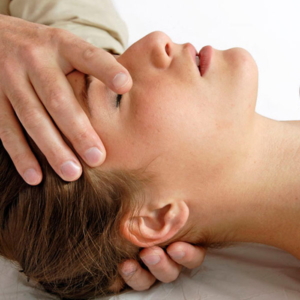What is craniosacral therapy?
Craniosacral therapy is an exceptionally gentle yet extremely powerful form of treatment increasingly recognized for the depth of its influence and the comprehensive range of its therapeutic effects. The main characteristic of craniosacral therapy is the correction of the micro-movements of the cranial bones. With that micro-manipulation, the therapist can influence other structures and all the organs and systems of the body. Craniosacral therapy primarily facilitates processes that enhance the body´s innate abilities for natural healing. One of the main goals is to improve the flow of cerebrospinal fluid.
Improving fluid flow and exchange enhances the functions of the central nervous system and effects all other bodily systems, e.g. the immune system, the cardiovascular system, the digestive system. Therefore, CranioSacral Therapy is useful for most chronic conditions and as a preventive therapy.
The Anatomical Basis of CranioSacral Therapy
The medical basis of CranioSacral Therapy is the craniosacral system, which is a physiological system found in all living beings with a brain and spinal cord. The craniosacral system begins functioning in the womb and continues its function until death. The name “craniosacral” is derived from the system’s associated bones. Included are those of the cranium (skull, face and mouth and of the spinal column which extends down to the sacrum, the triangular bone between the ilia (hips). It is contained within a tough waterproof membrane, called the dura mater, which surrounds and protects the brain and the spinal cord. In the head, this dural membrane attaches to all the cranial bones. In the spine, it attaches to the 2nd and 3rd vertebra of the neck, to the sacrum and to the coccyx (tailbone). An important function of the craniosacral system is the production, circulation and reabsorption of cerebrospinal fluid that maintains the physiological environment in which the brain and nervous system develop, live and function. All the nerves in the body originate along the pathway of the dural membrane system. Restrictions along the dura occurring from physical or emotional events may cause dysfunction and pain at some points in the body. All the bones attached to the dural membrane move constantly as the cerebrospinal fluid is pumped in and out. Each bone has its own movement. When a particular bone moves off course or does not move at all it indicates there is a restriction in the cerebrospinal fluid flow. An imbalance in this system can adversely affect the development of the brain and spinal cord. This can result in sensory, motor and neurological dysfunction. The craniosacral system works in conjunction with other body systems such as the cardiovascular, respiratory, musculoskeletal, endocrine and nervous system. All parts of the body are affected by the functioning of the craniosacral system
The Craniosacral Rhythm
The craniosacral system, like the cardiovascular and respiratory systems, has its own palpable rhythm called the craniosacral rhythm. The normal craniosacral rate is 6-12 cycles per minute, which remains unaffected by emotions, exercise and so on. The motion of the cranial bones is transferred to and taken up by the peripheral bones of the body, the connective tissue and all the organs. Hence, the motion becomes a whole body motion. The motion of the cerebrospinal fluid creates a pulse that called the craniosacral rhythm. A trained craniosacral therapist can palpate this rhythm to evaluate the movement of the cerebrospinal fluid throughout the body as well as to detect any variances or possible restrictions in the flow of the cerebrospinal fluid. When a restriction has been found, the therapist will assist the natural movement of the fluid and related soft tissue to help the body self-correct, to develop spinal flexibility and to improve general health and well-being.
Summary
CranioSacral Therapy is completely different from standard massage, chiropractic and osteopathic adjustments. The techniques used during a session are extremely subtle, sensitive and gentle; they are not at all sharp, hard or quick. The craniosacral therapist follows the body’s natural rhythms to effect positive changes in the body.
CranioSacral Therapy is a subtle and profound healing form, which encourages the body’s natural mechanisms to improve the functioning of the brain and spinal cord, dissipates the effects of stress and enhances general health and resistance to disease.
This post is also available in: Spanish




